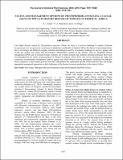| dc.contributor.author | Ndala, R | |
| dc.contributor.author | Ndakidemi, P | |
| dc.contributor.author | Mbega, E.R | |
| dc.date.accessioned | 2024-03-18T11:07:04Z | |
| dc.date.available | 2024-03-18T11:07:04Z | |
| dc.date.issued | 2019 | |
| dc.identifier.uri | https://www.cabidigitallibrary.org/doi/pdf/10.5555/20193463950 | |
| dc.identifier.uri | https://dspace.nm-aist.ac.tz/handle/20.500.12479/2485 | |
| dc.description | A research article was published by The Journal of Animal &The Journal of Animal & Plant Sciences, 29, 2019 | en_US |
| dc.description.abstract | Late blight disease caused by Phytophthora infestans (Mont.) de Bary is a serious challenge in tomato (Solanum
lycopersicum L or Lycopersicon esculentum L) production worldwide. In tropical Africa, the disease is increasing always
due to its biology and different complex infection mechanism(s) used by its causative pathogen to survive, spread, and
invade the tomato host plant and environment. Management options of the disease, such as integrated disease
management (IPM), use of resistant tomato varieties, use of plant extracts and synthetic chemical pesticides have been
recommended but are either poorly practised or limited in tropical Africa. Thus, this review discusses the status and
commonly recommended management options against late blight disease-causing pathogen(s) including the pathogen
strain complexes so that tomato growers and other stakeholders can understand specific strains and how they can design
appropriate managerial approaches to halt challenges of the disease in tomato production in the tropical Africa. | en_US |
| dc.language.iso | en | en_US |
| dc.publisher | cabidigitallibrary | en_US |
| dc.subject | Host range | en_US |
| dc.subject | Pathogen infection Mechanism | en_US |
| dc.subject | Sign and Symptoms | en_US |
| dc.subject | Plant extract | en_US |
| dc.title | STATUS AND MANAGEMENT OPTIONS OF PHYTOPHTHORA INFESTANS, A CAUSAL AGENT OF THE LATE BLIGHT DISEASE OF TOMATO, IN TROPICAL AFRICA | en_US |
| dc.type | Article | en_US |

